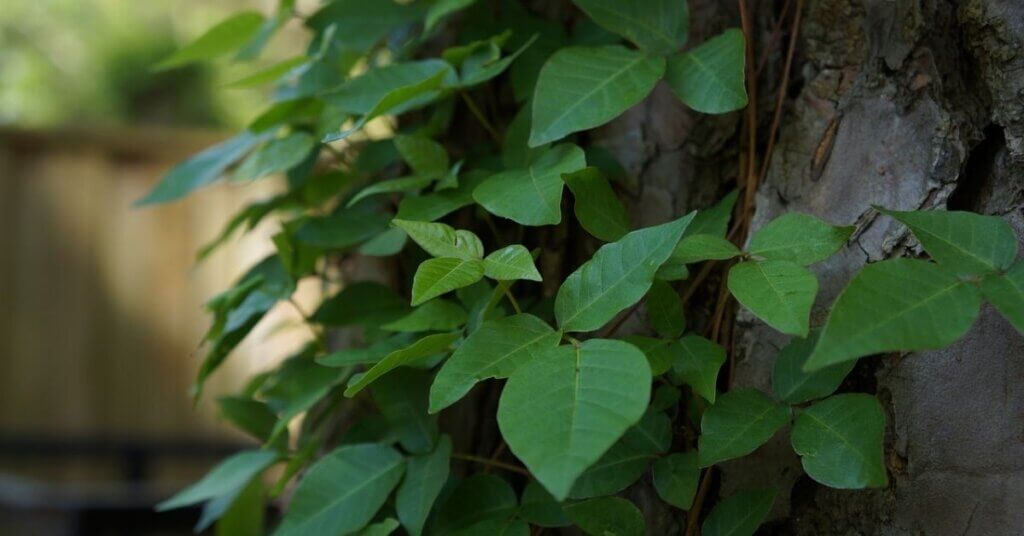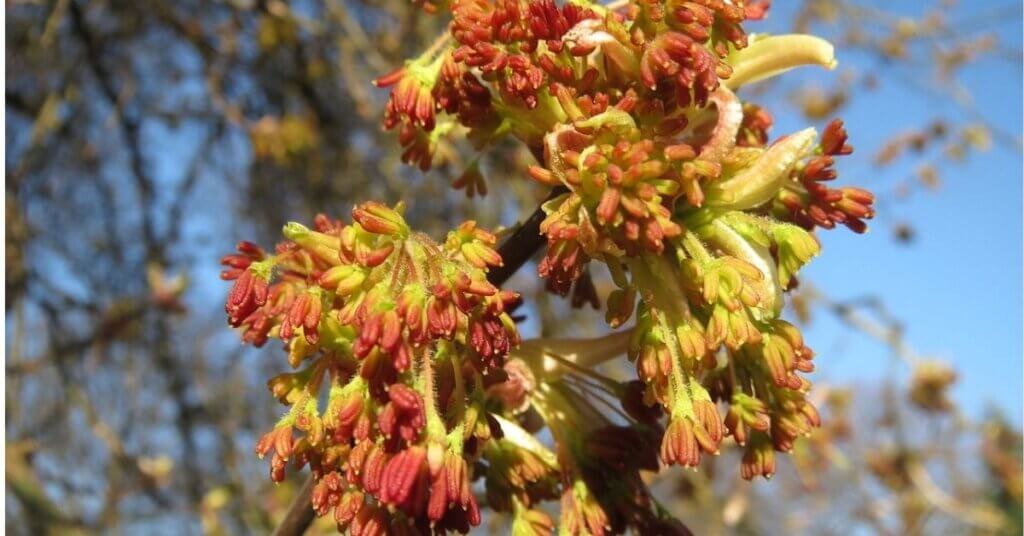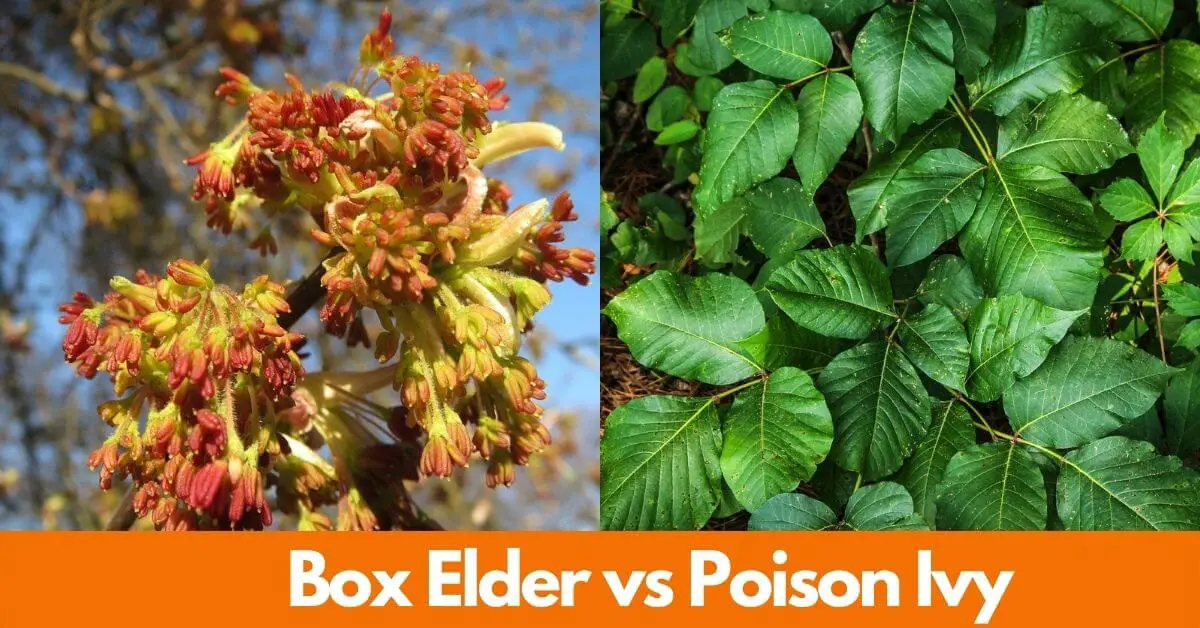Box Elder
Box elder(Acer negundo) is also called boxelder maple, Manitoba maple, or ash-leaved maple. It is a fast-growing tree and native to North America. The box elder tree is found in almost every area of the United States. These trees have brittle, weak wood. Trees break easily in the wind.
Box elder can grow well in full sun or partial shade. It needs sand and well-drained soil for its good growth. It can be planted easily.
Poison Ivy
Poison ivy (Rhus radicans) is a type of allergenic plant, a shrub, or climbing vines. It is native to Asia and North America. There are more than 30 species of Poison Ivy. It contains a resin. Touching it causes a very unpleasant skin rash.
| # | Box Elder | Poison Ivy |
| Scientific Name: | Acer negundo | Rhus radicans |
| Tree/Vines Size: | 35-80 ft (10-25 m) tall, 1-2 ft (.3-.6 m) trunk diameter. | Vine can grow more than 100 feet long and six inches thick. |
| Average Dried Weight: | 30.2 lbs/ft3 (485 kg/m3) | – |
| Janka Hardness: | 720 lbf (3,200 N) | – |
| Wood Color: | grayish/yellowish brown to pale white | – |
| Workability: | Easy to work | – |
| Uses: | Turned objects, small ornamental objects | To make medicine |
| Rot-resistant: | Not rot resistant | – |
How to Identify Box Elder and Poison Ivy?
The Box Elder and Poison Ivy both look similar when they are small. But it is important to recognize Poison Ivy as it is harmful to you and your pet. They can be easily recognized on the basis of their leaves, flowers, and fruits.

Box Elder vs Poison Ivy leaves
| Box Elder leaves | Poison Ivy leaves |
| Boxelder leaves are pinnate with a single leaflet at the stem. | Compound leaves (a number of leaflets on a common stalk) with three leaflets. Leaves are Alternately arranged. |
| They are odd-pinnate with three to five leaflets. The shape of the leaflet is lanceolate, ovate and the leaves margin is serrated. | The middle leaflet is larger than the other two leaflets. |
| The middle leaflets are larger and wider than the rest of the leaflets. | They are typically 2 to 5 inches long. But reach six or more inches if conditions are right. |
| Light green above, paler green below. The leaves turn yellow or orange before falling. | Poison Ivy Leaves may be red or green, shiny or dull. |
| Sometimes they may have whitish-colored blotches or margins. | The leaves fall in winter and grow new ones in the spring. Young leaves are dark red and shine but later turn green. |
| Leaflet blade length can be 2 to 4 inches long. | Young leaves have rounded tips while mature leaves have sharp tips. |
Box Elder vs Poison Ivy Flowers

| Box Elder Flower | Poison Ivy Flower |
| Box Elder is a dioecious tree. That means male and female flowers occur on separate trees. | In the beginning, the flowers develop in the form of buds. |
| The male flower (cyme) is red, the female flower (hanging grapes) is yellowish. | Flower buds are small and green or greenish-yellow and form clusters. These buds are close to the vine. |
| The flower appears before the leaf shoots. | PoisonIvy flowers grow in clusters, just like the buds, and bloom in the spring. |
| Male and female flowers hang in clusters on the branches and bloom in May and April. | Flowers are off-white, with orangish centers. |
Box Elder vs Poison Ivy Fruit
| Box Elder Fruit | Poison Ivy Fruit |
| The box elder fruit contains a single seed with an attached wing called a samara. | The fruits of Poison Ivy are called berries. |
| Each samara is maybe 1 to 2 inches long. | These berries are white, gray, or cream in color. |
| It appears in the mid-spring and V-shaped pairs that hang in drooping clusters. | The outer skin of the berries is green during spring. But before the fall in summer, it becomes pale yellow. |
| The fruit is about ½ to 2 inches long. Maturing in autumn and persisting in the spring. | The berries are grown in a grape-like cluster and attached to the stems. |
| The Box elder fruits fall from the trees in September. | Many types of birds consume berries. It is not harmful to them. |
Box Elder and Poison Ivy Identification
| Box Elder bark | Poison Ivy Vines |
| Gray to light brown and thin, with shallow interlacing ridges. | The vines of young trees are green while older vines turn brown and hairy. Vines can be six inches thick and can be climb trees, fences, and walls. |
Effects of Poison Ivy on Human Skin
As the name suggests, Poison Ivy can be dangerous. but how much?
Poison ivy plant leaks oil after being bruised, damaged, or burned. This oil is caused by an allergic reaction. Oily resin is called urushiol (u-ROO-she-ol). This oily resin is found in the leaves, stems, and roots of poison ivy plants.
Allergies can be caused by exposure to or touching the oily resin, But this allergic reaction does not occur in 15 to 20% of people. But most people have a greater reaction with repeated or more concentrated exposure. Only 50 to 60 micrograms of urushiol are enough to cause the reaction.
The skin rash can last for 5 to 15 days, sometimes a month or more. In such a case, the affected person should immediately consult a skin doctor. According to Wikipedia, Over 350,000 people are affected by urushiol in the United States per year.
How to avoid the effects of Poison Ivy?
- Don’t try to remove or touch poison ivy leaves, branches, roots, or stems with your bare hands or any exposed skin.
- Never burn its leaves, branches, roots, or stems.
- Wear a protective cloth before removing its plant.
- If you are exposed to poison ivy, immediately wash with soap areas of the skin that may have touched the plant.
Working with Box Elder wood
Easy to work with both hand and machine tools. Turns glues, and finishes well.
Be careful while working because box elder is reported to cause skin irritation, runny nose, and asthma-like respiratory effects.
Is box elder firewood?
Box elder is not better firewood. Because it does not produce high heat during burning and burns quickly. Its behavior is like softwood. For good firewood, the density of the wood should be high.


